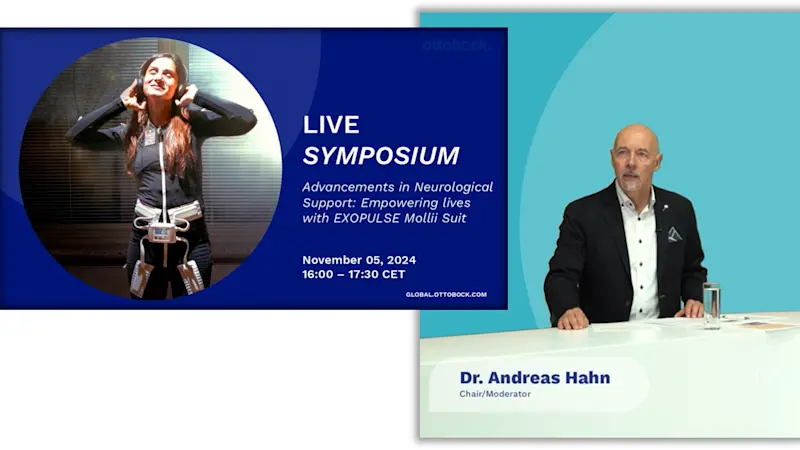Groundbreaking research results in neurological care
Expert opinions in the online symposium “Advancements in Neurological Support: Empowering lives with Exopulse Mollii Suit”

Friday, 15 November 2024
At the beginning of November, renowned experts presented ground-breaking research results on innovative treatment methods for chronic diseases at the online symposium “Advancements in Neurological Support: Empowering lives with Exopulse Mollii Suit”: from the potential of non-invasive therapies for fibromyalgia and key findings from the integration of psychophysiology into sports science to the first promising data from the ongoing studies on the effect on patients with stroke and multiple sclerosis. The studies confirm the effectiveness of the neuromodulation Exopulse Mollii Suit in the treatment of fibromyalgia and spasticity.
Dr. Andreas Hahn, Corporate Vice President of Clinical Research and Services at Ottobock Healthcare Products GmbH in Vienna, Austria, moderated the event.
International experts were invited to present their research results, findings and innovations in the fields of neurophysiology, sports science and neurology in order to promote the cooperative exchange of knowledge:
Prof. Samar S. Ayache, MD, PhD, HDR, kicked off the event. She is an Associate Professor of Clinical Neurophysiology at the Faculty of Medicine of the University of Paris-Est in Créteil, France, and at the Lebanese American University School of Medicine in Beirut, Lebanon. Prof. Ayache is also a practicing neurologist and neurophysiologist at the Henri Mondor Hospital in Créteil. Her work bridges the gap between advanced neurophysiological research and clinical practice, benefiting patients and academics alike.
Her contribution was followed by guest speaker Dr. Alejandro Rubio Zarapuz, BSc, MSc, PhD, Director of the Master's Degree in Research in Sports Science and Exercise Science at the Faculty of Sports Science of the Universidad Europea de Madrid, Spain. He is also a Full professor of Physiology, Training Methodology and Research Methodology. His research with the Applied Psychophysiology Group focuses on the integration of psychophysiology into sports science. The results are incorporated into the training methods and research practices at the Universidad Europea de Madrid.
Prof. Dr. Naji Riachi, BS, MD, Medical Director of the Burjeel Neurosciences Center in Abu Dhabi, UAE, where he also heads the Epilepsy Services, concluded the event. Prof. Riachi is a Professor of Neurology at Khalifa University in Abu Dhabi and brings his extensive expertise in neurology to both clinical and academic institutions in the UAE and beyond.
Studies at a glance:
1. Prof. Ayache on the non-invasive treatment approaches for fibromyalgia
Among the topics Prof. Ayache addressed at the conference were the difficulties in treating fibromyalgia, the high prevalence of the disease in the United States and worldwide, and the complexity of the disease's biology. In many cases, pharmacologic and alternative therapies to treat fibromyalgia do not meet patient expectations. Therefore, non-invasive stimulation approaches appear to be particularly relevant in this area, although their role has not yet been precisely determined. For this reason, a study was conducted at the Henri Mondor Hospital. The aim was to investigate the effects of the Exopulse Mollii Suit for transcutaneous electrical nerve stimulation with a focus on pain, fatigue, emotional symptoms and patients' quality of life.
Phase 1 of the study was randomized with a cross-over sham drug-controlled double-blind design. Phase 2 was an open-label study. The primary outcome of the study was the visual analog scale (VAS) for pain. The other questionnaires for pain, mood, quality of life and disease impact were based on the Hospital Anxiety and Depression Scale (HADS), the Brief Pain Inventory (BPI), the Pain Catastrophizing Scale (PCS), the Visual Analogue Scale for Fatigue (VAS fatigue), the Short Form 36 (SF 36) and the Fibromyalgia Impact Questionnaire (FIQ).
With an average age of 51.3 years, 33 participants (93.9 percent females) completed the trial. Following active intervention, pain (the primary endpoint) was significantly reduced compared to sham treatment according to the VAS and a subscale of the BPI. The exception was the results of the PCS. Apart from depression, many of the secondary endpoints (fatigue, anxiety, disease impact and some aspects of quality of life) also showed significant changes. In Phase 2, most outcomes improved significantly, including depression and almost all aspects of quality of life. In phases 1 and 2, patients reported clinical improvement in 63.6 percent and 78.8 percent of cases, respectively.
Prof. Ayache concludes: “The nociceptive effects were achieved after two weeks of active treatment; however, a longer stimulation protocol seems to be required to modulate the affective and cognitive components of pain. [...] The study showed promising results in a difficult-to-treat condition, especially in patients who responded poorly to available pharmacologic and non-pharmacologic treatments.” She suggested some potential underlying mechanisms, including the gate control theory and modulation of the central sensitization phenomenon. According to the former, activation of large-diameter sensory fibers triggers inhibitory mechanisms in the brainstem and spinal cord that prevent painful impulses from reaching the brain. The second mechanism states that cortical network activity is modulated after transcutaneous electrical stimulation.
2. Innovative treatment methods offer new hope for fibromyalgia patients: Dr. Alejandro Rubio Zarapuz presents the key findings
Dr. Alejandro Rubio Zarapuz presented groundbreaking research on the effects of the Exopulse Mollii Suit and combined non-pharmacological therapies for the treatment of fibromyalgia. In a comprehensive presentation, he unveiled findings of three critical studies exploring the efficacy of neuromodulation, virtual reality (VR) integration and structured exercise programs. The research results show significant advances in pain management, muscle oxygenation and functional capacity in fibromyalgia patients, where conventional treatments are often inadequate.
Fibromyalgia, which is characterized by widespread musculoskeletal pain, fatigue and cognitive dysfunction, affects millions globally. Dr. Rubio Zarapuz studies examined the Exopulse Mollii Suit. The findings of the first study indicate that a 60-minute session with the Exopulse Mollii Suit leads to a measurable reduction in pain intensity, an improvement in muscle oxygenation and increased parasympathetic activity. These results underscore the suit's potential as an important tool for non-invasive, self-administered pain relief.
The second study explores the synergistic effects of combining the Exopulse Mollii Suit with VR protocols. Patients reported an improvement in balance, functional strength and pain perception, especially when VR was integrated with neuromodulation. The immersive experience provided by VR adds a unique therapeutic dimension that can potentially improve treatment efficacy.
In the third study, Dr. Rubio Zarapuz evaluated high-intensity interval training (HIIT) in combination with the Exopulse Mollii Suit in a randomized crossover format. The results showed that both interventions significantly reduced pain and improved muscle oxygenation. Neuromodulation is particularly suitable for patients for whom training programs cannot be carried out or can only be carried out at a significantly reduced intensity.
“This study offers promising pathways for managing fibromyalgia and underscores the value of combined, non-pharmacological therapies,” said Dr. Alejandro Rubio Zarapuz. “The integration of neuromodulation, VR and exercise offers a multi-faceted approach that can address the complex symptoms of fibromyalgia, which are often resistant to conventional treatments.”
The findings mark a significant step forward in the quest to provide fibromyalgia patients with effective, accessible and self-administered treatment options. Dr. Rubio Zarapuz advocates for further research on these therapeutic combinations and emphasizes their potential to transform people's lives by enhancing pain management, functionality and overall well-being.
3. Prof. Riachi presents promising data from the two studies on neurostimulation in the treatment of spasticity
The two studies are currently being conducted at two centers in France and Abu Dhabi. They involve patients who suffer from a spasticity-induced movement disorder, for example due to multiple sclerosis or stroke. Spasticity is a common and disabling condition that affects gait, balance, mobility and quality of life. Unfortunately, currently available treatments are associated with significant side effects, leaving a significant unmet need in these patients. Therefore, a non-invasive, non-pharmacological treatment method such as neurostimulation with the Exopulse Mollii Suit could be helpful for this target group.
The studies are conducted in two phases: an initial randomized, placebo-controlled, double-blind study with a crossover design, followed by an open-label phase. In the multiple sclerosis study, preliminary data from the open phase showed improvements in the Berg Balance Scale, the primary endpoint of the studies. Videos of patients demonstrate improved mobility, with less need for walking aids, smoother movements, increased stride length and speed, in addition to improved balance and commuting gait.
As far as the stroke study is concerned, the preliminary analysis of the open phase also showed improvements in the Berg Balance Scale. Videos demonstrated the noted improvement in hip flexion as well as increased speed and optimized stride length. Despite the short stimulation periods, very encouraging results were noted in the upper limb. “This would require studies with longer stimulation periods,” said Prof. Riachi.
The mechanism of action of the Exopulse Mollii Suit is thought to be mediated by the reciprocal inhibitory reflex. Prof. Riachi explained that “modulation of this mechanism will lead to activation of the inhibitory neurons in the spinal loop. If you stimulate the antagonist of the spastic muscle, this leads to a reduction in the excitability of the motor neurons in the spastic muscle and thus to its relaxation.” This can be applied to all muscles in the body and can be individually tailored to the clinical needs of each patient.
These studies will soon be completed, and the analysis will include secondary endpoints such as pain, mobility, spasticity and quality of life.
Symposium wrap-up
At the end of the symposium, Dr. Hahn summarized the key takeaways and highlighted two important fibromyalgia projects. They provided valuable initial results but also indicated that the true potential may only be realized through long-term treatment. Dr. Hahn also emphasized the potential benefits of a combined treatment approach. In addition, participants were given a first look behind the scenes of ongoing studies investigating the effects of the Exopulse Mollii Suit on patients with spasticity.
Neurostimulation offers great potential
The current studies demonstrate the promising potential of non-invasive treatment methods to improve the quality of life of patients with chronic diseases. The study, led by Prof. Ayache, highlights the Exopulse Mollii Suit as an effective tool for the treatment of fibromyalgia, significantly reducing pain, fatigue and anxiety. While immediate nociceptive benefits have been observed, a longer duration of treatment may be required to address the cognitive and emotional aspects of pain. Similarly, Dr. Alejandro Rubio Zarapuz's research highlights the effectiveness of neuromodulation, virtual reality and exercise programs in the treatment of fibromyalgia, showing improvements in pain and functioning. The preliminary results of Prof. Riachi's studies indicate that neurostimulation with the Exopulse Mollii Suit can significantly improve balance, mobility and motor function in patients with multiple sclerosis and stroke. These results give hope to patients struggling with conditions that do not respond to conventional therapies and emphasize the importance of continued research to refine these treatments and fully explore their long-term benefits.
To view the recording of the symposium, please register by clicking on this link: Advancements in Neurological Support: Empowering lives with EXOPULSE Mollii Suit After successful registration, the link to the recording will be sent in the confirmation email.

